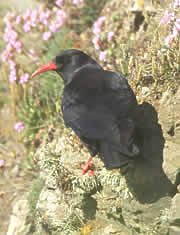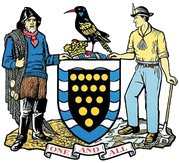


Web: www.chough.org
Proper Cornish bird
The Chough is a member of the crow family with a red beak and legs, and an excitable, high-pitched 'chi-ow' call from which it gets its name. It is extremely acrobatic and its tumbling display flights make a truly impressive sight.
The Chough is included in the county's coat of arms alongside the miner and the fisherman, reflecting the bird's importance in Cornish culture. It also appears regularly in Cornish legend and it is said that King Arthur was transformed into a Chough when he died, the red feet and beak representing his violent, bloody end.
The Chough was once widespread around the coasts of Britain but has declined since the early 19th century, with only about 300 pairs left, mainly in Wales, the Isle of Man and western Scotland, although a larger population is present in Eire. A decline in suitable feeding habitat is thought to be the main reason for the loss of the Chough from England, with many of the well-grazed pastures that were once common along the coast ploughed up for arable crops or overgrown with scrub.
Cornwall was once a stronghold for Choughs, they last nested in the county in 1952, long after they had been lost from the rest of England. As the Chough declined, so it became an increasingly prized target for egg collectors and trophy hunters and this may have finally sealed the bird's fate in Cornwall.

Conservation organisations hoping to see the Chough back in Cornwall have been working together for a number of years to secure more and better quality Chough habitat. It prefers short well-grazed coastal pastures and eats ground-dwelling invertebrates such as ants, beetle larvae and spiders. Its rather untidy nest is built largely of sticks and usually well concealed within a crack in the cliff-face or deep inside a cave.
By 1910, the Chough had disappeared from all southern coastal counties of the UK with the exception of Cornwall, but even here there was concern that it was doomed to extinction, with reports that former haunts on the north coast remained unfrequented.
The year 1947 saw the last successful nesting attempt in Cornwall. An ageing pair of Choughs lived near Newquay between 1960-1967 but one of the pair was found dead in March 1967. Its partner patrolled the cliffs alone until 1973 when it too, the last of the Cornish Choughs, was seen no more.
For the next 28 years, Choughs remained absent from Cornwall, the only recorded sightings being of a few birds passing through or escaped from captivity. The natural return of Choughs to Cornwall changed all that!
A team of dedicated volunteers provided a round-the-clock watch over the birds to ensure illegal egg collectors could not raid the nest and thereby ruin any chance of the Chough returning to Cornwall.
It is hoped that by providing more habitat for Choughs to feed and breed on, such as that managed under the Countryside Stewardship Scheme, this most evocative and emblematic of Cornish birds will be able to make a full natural recovery.
Currently, there are thought to be around 500 pairs of the birds, mostly in Wales and on some of the western Scottish islands such as Islay. They are also present on the Isle of Man and in Ireland and Brittany.
Early in the spring of 2001, there was a small influx of wild Choughs along the south coast of England, from Portland in Dorset to the Isles of Scilly and a group of three took up residence on the Lizard Peninsula.
In 2002, two of the birds bred, the first time in Cornwall in more than 50 years. Since then this pair have nested each year - raising 20 youngsters, many of which are now to be found on the Lizard or Land's End peninsulas.
Another milestone was reached in 2006 when a second pair (a male offspring of the Lizard pair, and an incoming wild female) successfully bred raising 3 young.
In 2007, two pairs of Choughs again bred successfully in Cornwall fledging nine young between them.
Cornwall's History Cornwall's Wildlife